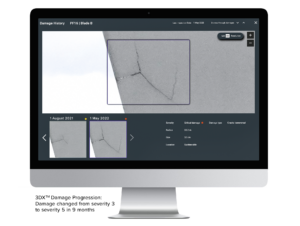Wind energy is one of the fastest growing renewable energy technologies. Over the last decades, the global installed wind energy generation capacity has increased drastically from 7.5 GW in 1997 to 823 GW in 2021 (1). Last year alone, 92 GW of new capacity was added, of which 20 GW was offshore and this expansion is set to continue over the next decades. However, maintenance of wind turbines remains an important cost factor, and one that is likely to increase as the development of larger wind turbines, together with the maintenance of aging fleets, lead to increased repair requirements. So, what savings can be made to lower repair costs and increase AEP?
A recent report (2) showed that onshore wind farm operators spent around USD 15 billion on operations and maintenance services in 2019, 57% of which was on unplanned repairs. An analysis of wind turbine blade failure revealed that two of the most observed damage mechanisms were structural cracks and surface damages. These are damages that can be identified with visual inspection at an early stage.

The Sulzer Schmid 3DX™ Blade Platform is the ultimate tool for processing, reviewing, and analysing visual inspection data of rotor blades. Now, thanks to a unique damage progression feature, it is possible to identify damages at an early stage and predict their evolution. The result: early intervention to repair damages before they become serious, reducing repair costs, downtime and optimizing AEP.
A data-driven approach to decision making
The 3DX™ Blade Platform is flexible, modular, and scalable to meet the evolving needs of our customers. It can manage many kinds of inspection data and use the customer’s unique taxonomy to link seamlessly with their existing processes and systems. As such, it facilitates access to both historical and current data, enabling a smooth annotation workflow. Intelligent analysis of the data, using a large range of AI-enhanced functionalities, can provide a dynamic insight into failure rates and damage propagation that can be used to make informed decisions.
 Our new Damage Progression module with its unique damage ID component, enables us to monitor damage and compare it with data acquired over the years. With this feature, the evolution of damages such as leading-edge erosion can be tracked in a so-called “damage chain” and displayed in a time series of recorded inspections. Knowing how damages develop over time allows blade experts to determine which damages need to be repaired now, in 6 months, or later. This significantly improves the planning and efficacy of repair campaigns.
Our new Damage Progression module with its unique damage ID component, enables us to monitor damage and compare it with data acquired over the years. With this feature, the evolution of damages such as leading-edge erosion can be tracked in a so-called “damage chain” and displayed in a time series of recorded inspections. Knowing how damages develop over time allows blade experts to determine which damages need to be repaired now, in 6 months, or later. This significantly improves the planning and efficacy of repair campaigns.
Prevention is better than reparation
Leading-edge erosion, for example, can become an issue after only 2 years of turbine operation. This type of surface damage increases the drag coefficient, which in turn leads to a reduction in AEP of up to 5%. When combined with fatigue, it is also one of the major causes of rotor blade failure. Customers typically repair damages categorised with a high severity level. But repairing damages before they reach this level of severity, means they not only lower the cost of repairs, they can also restore the turbine AEP and prevent a certain number of rotor blade failures.
Our 3DX™ Blade Platform is a powerful asset management tool that enables OEM, Owners and Operators to make informed decisions about their assets in a way that fits with their processes, strategy and ambitions. The platform provides transparency, which allows customers to work more efficiently both within their organization and with partners. The deep link function means that information relating to specific damages can easily be shared, enabling repair companies to provide reliable quotes, and facilitating discussions with customers, insurance companies or any other parties.
Monitoring wind assets now easier and more efficient

Understanding customer needs and adapting our solution package to meet these needs is guiding everything we do. Together with our customers, we have developed a number of solutions over the years, and we will continue to do so. Lightning strikes, for example, are one of the main causes of rotor blade damage; we recently launched a new feature which combines LPS and rotor blade inspections in one flight and incorporates the data into our platform. Another recent development is our module for thermal inspections to validate the proper functioning of the de-icing system. Thanks to our 3DX™ Blade Platform, monitoring wind assets has become easier and more efficient than ever, ultimately lowering the cost of renewable energy.
Contact Marc Hoffmann if you are interested in finding out more about our 3DX™ Blade Platform and how its damage progression module lays the foundation for predictive maintenance.
- IRENA Wind Energy Statistics 2021
- Root Causes and Mechanisms of Failure of Wind Turbine Blades: Overview Leon Mishnaevsky, Jr.